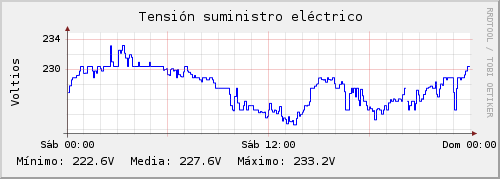Electric shock
Last Friday I was tinkering with apcupsd and rrdtool and decided to join both: I’d monitor the mains voltage during a period of 24 hours, to see if it varied during the day. Well, apparently, it does.

To my untrained eye it looks like it varies with the load in the electric network: the voltage is at its highest during nighttime, and hits its lowest point at 13:30 (solar mid-day in Galicia); then rises again while people is having lunch then dips until after 18:00. The discontinuity at about 20:15 was due to my briefly stopping apcupsd to change a configuration in my UPS.
Now, I don’t know if the mains voltage really varies so much during the day or if it is because my UPS’s voltmeter is a piece of shit (which it, apparently, is) and is affected by the presence of non-resistive loads or whatnot, but the graph is interesting anyhow. Detailed explanations by people who know more about electricity than yours truly will be appreciated.
On an unrelated subject, I’m teaching myself how to juggle a reverse cascade. To do it properly, it requires better timing and more homogeneous throws than I’m currently able to do. So, to master it, I first need to suck less at juggling. We’re working on it.
That graph should be mostly accurate. Line voltage does vary based on load. It is a factor of the current carried by the big transmission lines and the inductive and capacitive coupling between the different power phases. The voltage of underground cabling varies more then overhead cabling as the wires are closer together hence the coupling is greater. There is more to it but I can’t remember that part of my power transmissions class.
There are standards that dictate how much the voltage can vary. In North America (120v) I believe it can vary between 109v and 124v. The 120v standard used to be a 110v or 115v standard depending on where you were.
I believe there is a much simpler answer to your question. Transmission lines are not ideal conductors and have some electrical resistance. Same is true for coils in your local transformer (the device that converts higher voltage used on local transmission lines to 240V used in households). The higher the electric current that flows through them, the higher the voltage drop over them (according to Ohm’s law). So even if your local power plant provides constant 240V on their end of the network the voltage in your house will be 240V minus the voltage drop over the transmission lines and will always depend on the current consumption in your neighborhood. The distribution company usually tries to compensate for long-term variations by adjusting the transformers, but the short-term (daily) variations you see are normal.
I have observed similar voltage swings in the distribution network with my UPS (see this post. I have also checked the measurements taken by my UPS (a cheap Belkin something) with a multimeter and they seem correct. From my experience even cheapest voltmeters you can get today are quite accurate so I would trust your UPS.
I don’t see how non-resistive loads could significantly alter voltage measurements.
Hope you’ve practised the half-shower(?) each way, and ‘tennis’ ? :)
–
Neil
Neil: of course! :)